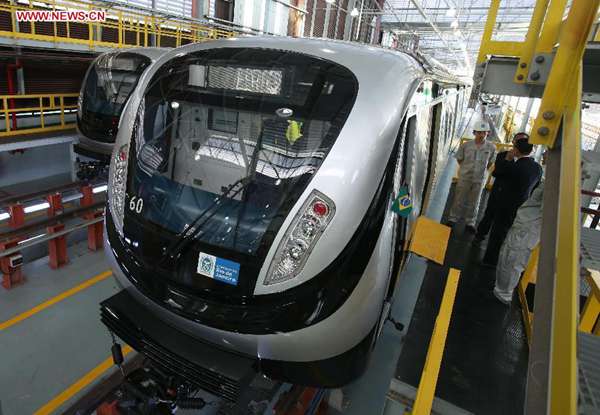

 |
| Photo taken on May 20, 2015 shows a Chinese-made subway train for the Olympic special line in Rio De Janeiro, Brazil. (Xinhua/Pang Xinglei) |
With a series of high-end Chinese manufacturing products being exported to other countries, Made in China is no longer synonymous with cheap clothes. As reform gathers pace, Chinese brands bring dynamism to the economy.
Chinese equipment has made a series of recent breakthroughs in overseas markets. Deutsche Bahn AG, the German railway company, is considering buying trains and accessories from China. A promotion event for the ACP1000, China's self-developed advanced pressurized water nuclear reactor, attracted representatives from Britain, France, the U.S. and Canada. Dalian Locomotive and Rolling Stock recently received an order for 112 metro train carriages from India.
Through the transformation and upgrading of the equipment manufacturing industry, we witness growth in scale and increasing competitiveness on the part of China's manufacturing industry. However, China’s role in international industrial specialization still needs to be further promoted. It is expected that with the implementation of related policies, China’s high end manufacturing industry will become an important engine not only for China but also for the international economy.
Behind the good news on Made in China are China’s extensive and ongoing efforts in innovation. Taking new energy vehicles for example, from Jan. to April 2015, China produced 34,400 new energy vehicles, three times more than in the same period of last year. Within these figures, the production of pure electric passenger cars and plug-in hybrid vehicles tripled, while the production of pure electric commercial cars multiplied fivefold.
The upgrading of China’s manufacturing industry is also attracting the attention of international capital. According to statistics from the Commerce Ministry, the percentage of overseas capital used in China’s electronic equipment manufacturing, transport equipment manufacturing, and raw chemicals production, has increased by 4.8 percent, 4.4 percent and 2.0 percent respectively.
Zhou Qingjie, doctor at the Economics School of Beijing Technology and Business University, says that Made in China no longer generates ideas of cheap shirts, shoes and socks. In recent years, China’s manufacturing industry has made enormous progress, and a series of high-tech and high-added-value Chinese brands have emerged. This is not only because of the adjustment of China’s industrial policy but also thanks to the reform of state-owned enterprises and the national support to the high-end equipment manufacturing industry.
 Chinese students learn Duanwu customs in Hefei, Anhui
Chinese students learn Duanwu customs in Hefei, Anhui Abandoned village swallowed by nature
Abandoned village swallowed by nature Graduation: the time to show beauty in strength
Graduation: the time to show beauty in strength School life of students in a military college
School life of students in a military college Top 16 Chinese cities with the best air quality in 2014
Top 16 Chinese cities with the best air quality in 2014 Mysterious “sky road” in Mount Dawagengzha
Mysterious “sky road” in Mount Dawagengzha Students with Weifang Medical University take graduation photos
Students with Weifang Medical University take graduation photos PLA soldiers conduct 10-kilometer long range raid
PLA soldiers conduct 10-kilometer long range raid Stars who aced national exams
Stars who aced national exams
 New PLA campaign targets new recruits
New PLA campaign targets new recruits Island construction can benefit wider region
Island construction can benefit wider region Market studies
Market studies Zen harvest for Shaolin monks
Zen harvest for Shaolin monksDay|Week